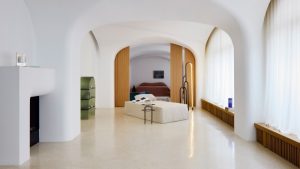How to create the perfect nook
Unlock the Editor’s Digest for free
Roula Khalaf, Editor of the FT, selects her favourite stories in this weekly newsletter.
Our instinct to burrow may have emerged at a time when we inhabited caves and sought solace and safety in the dark. Curling up in a confined space – albeit with more cushioning – has universal appeal. Nooks are synonymous with cocooning, and carving one out in the corners of a home conjures warmth.
“In small spaces, nooks play a part in achieving that feeling of protection and comfort,” says British designer Emma Ainscough, who’s snuck a bed in the eaves of a London townhouse, and wrapped another in cream linen surrounded by dreamy floral wallpaper.

Creating a place to retreat and relax has intensified with the advent of working from home. “Nooks bring about a very human response,” says Camilla Clarke, the creative director of design studio Albion Nord. “It’s important to consider how having a secluded space to escape enhances our wellbeing. I think it’s one of the reasons they have become so popular in recent years.”
For American interior designer Hadley Wiggins, the allure is also symbolic. “A nook represents the luxury of time – a lifestyle that has room for napping or an unrushed chat,” she says. “You may sleep there, but it isn’t the sleep of necessity.” When designing a historic home on Long Island’s North Fork – where she established her namesake firm in 2012 – Wiggins incorporated a fairytale-like sleeping berth, saturated in a palette of inky blues and putty green, in the pool house.


While some nooks invite seclusion, others draw people together. The creative consulting and interior design studio Wall for Apricots nestled a games area in a home perched in the California mountains, imagining it as a “treasured spot for a family to gather”, says co-founder Katy Burgess. An under-bench storage area conceals an assortment of games, while a custom Muhly table, a mix of vintage cushions, and wood tones add warmth and richness. “This area is a tiny emblem of the house itself, which was designed to be both functional and fantastical.”
Nooks are as practical as they are aesthetic and meditative, serving as cubby holes for leisurely activities while lending charm and purpose to underused, often awkward, parts of a house. “If designed properly, they can be very utilitarian while still being tailored to a specific location,” says Patrick Bernatz Ward, who runs an interior and architectural design firm in Los Angeles. When transforming a mudroom into a cloistered dining nook as part of a redesign of an arts and crafts-style house in Lincoln Heights, the designer created a “very distinct zone that felt intimate”.

Max Rollitt, an antique dealer and decorator known for his English country homes, attests to the increased demand for layouts that feel bespoke and intimate. “We’re seeing a reversal of open-plan living – walls and doors being put in, rather than taken out. People are spending more time at home and, in doing so, they’ve needed more of a delineation of space.” In the same way, he says, “nooks needn’t be architecturally led. You can create one almost anywhere simply by defining the space, be it with furniture or fabrics.”
Rita Konig says that nooks tap into our playful side. “They hark back to building dens – this is what speaks to people,” says the British interior designer. “It often conjures memories of making camps under the kitchen table with blankets,” agrees designer Veere Grenney, who pays homage to this in his enchanting tented dressing room in Tangier, where a writing desk and bed are canopied from ceiling to floor in Schumacher’s berber-brown Rafe Stripe fabric.


Grenney, who’s designed more than a dozen sleeping nooks for clients, often uses curtains to frame the bed with sumptuous swathes. But what are the other requisites for a good nook?
“It should ideally highlight a view and draw on the tones and shadows from the exterior,” says Bernatz Ward. “My projects typically involve blurring the lines between the natural environment and interior construction, and nooks – such as window seats – are a dramatic way to do that.”

Lighting, whether natural or artificial, is also crucial, says Noa Santos, founder of New York-based design studio Nainoa. In a project in California, the studio set a square bathtub in panelled waxed white oak, and placed it against a large window overlooking a courtyard. The space is airy, light but also snug.
Australian designer and decorator Lisa Burdus recommends using the nook space in its entirety. “Fill it completely with a desk or a seating arrangement so it feels cosy,” she says. For dining nooks, make every concession to comfort, taking cues from French designer Pierre Yovanovitch, Albion Nord and fabric designer Cathy Nordström, who often upholster banquettes with seat cushions.

Ainscough proposes adding “complementary layers of textures, colour and pattern to create something considered and maximalist without being too overwhelming”. She continues: “It’s a real opportunity to be bolder than you would be in a larger space.”
When it comes to the bed, “make it a cabin: give it sides, a lowered ceiling and use the space around it for storage,” says Konig, whose bed boxes resemble those on trains and ships, allowing for small spaces and creating a feel that is more intentional than squished. Grenney also suggests including shelving for books. Most importantly, he concludes, “just get on and do it! One of my mantras is that you shouldn’t make things too perfect.”
#create #perfect #nook





